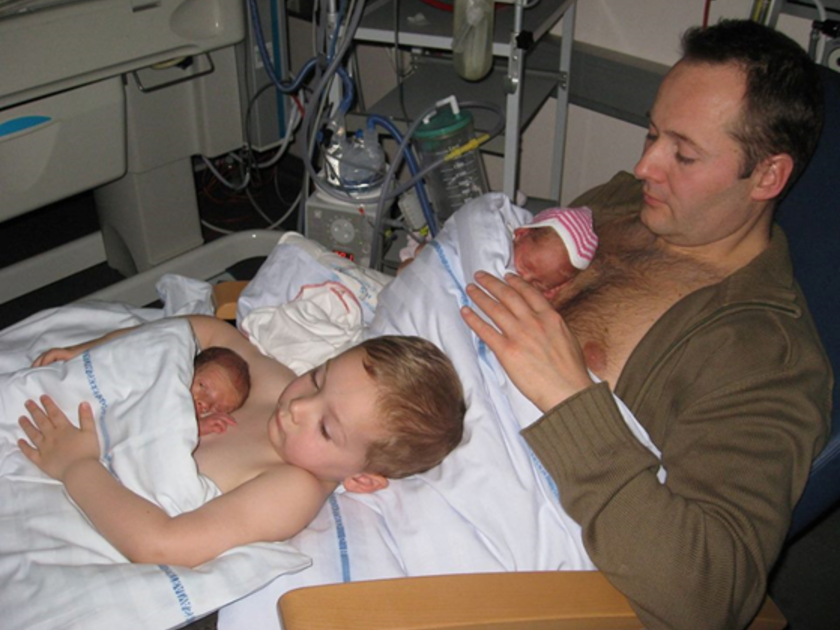- Study Says Most Parents Don’t Use Car Seats In Ride Share Vehicles Like Uber
- This 12-Year-Old Boy Is A Sophomore Aerospace Engineering Major!
- Fire Safety Experts Warn Of Hand Sanitizer Danger After A Mom and Kids Escape House Fire
- Recall Alert: Peaches May Be The Cause Of Salmonella Outbreak, 68 People Ill
- Summer Vacation In The Days Of COVID: Tips To Stay Safe
- How To Safely Grocery Shop During The Coronavirus Pandemic
- Michigan Teen With Vape-Related Illness Undergoes Double Lung Transplant
- Teen Kicks Off Anti-Vaping Campaign From Hospital Bed
- Teenager Receives Life Sentence For Strangling Sister To Death Over A Wi-Fi Password
- Toddler Falls To Death From 11th Deck of Cruise Ship
Kangaroo Care Is Not Just for Moms


See This Father and Son Cuddling Newborn Twins
We are all accustomed to seeing photos of new moms practicing kangaroo care, where she enjoys skin-to-skin contact with her baby.
But now, a picture of a father and his son cuddling newborn twins on their chests is winning the hearts of Internet users around the world.
After being posted to the Nino Birth Facebook page, the heartwarming image went viral. Because, its just so cute.
The uplifting image of a new dad and big brother both reveling in a sweet moment of skin-to-skin contact with a set of twins has gained over 33,000 reactions, and 30,000 shares.
The post also hints upon the benefits of kangaroo care.
We all know that preemies are aided greatly by sharing skin-to-skin contact with their mothers.
Kangaroo car can improve babies’ respiration, and can also help regulate their body temperature, among other things.
Featured Image credit: Nino Birth
Study Says Most Moms Are Not Putting Babies To Sleep Safely
Even with 23-years of campaigning to urge that babies be put to bed on their backs, only 43.7% of US mothers report that they both intend to use this method and actually do so all the time, according to a new study.
The Safe to Sleep campaign has been advising both caregivers and parents to use this position since 1994.
By placing babies on their backs before they go to sleep reduces the risk of sudden infant death syndrome, an unexplained fatal condition also known as SIDS, as well as other sleep-related infant deaths like suffocation, according to the US Centers for Disease Control and Prevention.
The study which was published this week in the medical journal Pediatrics, surveyed 3,297 mothers, of whom 77.3% reported that they usually — but not always — put their babies to sleep on their backs.
“What was new and hadn’t been explored before was this idea of what people intended to do versus what they actually do,” said Dr. Eve Colson, professor of pediatrics at Yale School of Medicine and co-author of the study. “What we found was that people intended to put their baby on their back but didn’t always do that.”
Another interesting finding was that those who felt the baby’s sleeping position was not up to them, but the baby or another family member were more than three times as likely to place the baby on its stomach.
The two main critiques of back sleep were the fear that the baby may choke and that it’s less comfortable than having them sleep on their stomachs, Colson said.
These beliefs may be from lack of education, as well as cultural and familial influences, said Dr. Robin Jacobson, a pediatrician at Hassenfeld Children’s Hospital at NYU Langone Health, who was not involved in the study.
Many previous generations had their babies sleep on their stomachs, she said.
“Grandmothers and aunts and everybody have told (mothers), if they have babies sleep on their bellies, they’re more comfortable; they’re not going to choke,” she said. “And because of that, a new mom who doesn’t really have a lot of information is using information from everybody else in their life.”
The research oversampled Hispanic and African-American women so that adequate comparisons could be made across racial groups, the authors said. African-American mothers were reported to be least likely to put their babies on their backs, compared with the other demographics.
About 3,700 sudden unexpected infant deaths were reported in the US in 2015, according to the CDC.
SIDS account for 1,600 of those while 1,200 are due to unknown causes and 900 were due to accidental suffocation as well as strangulation while in bed.
“There’s very much a culture of putting babies on their stomach in an African-American community,” said Moon, who was not involved in the new study. “There’s a lot more dependence on grandmothers and other senior family members as trusted sources, and lots of times, the information that you get from your family members is more persuasive than what you get from physicians and other sources.”
Moon also added that parents perceive babies to be uncomfortable if they are frequently waking or crying while on their backs, so they let the child determine the sleeping position.
“I think the fact that parents don’t feel like they have control is something we can talk about,” she said. “It’s often the child that’s the queen or the king of the household. And I think parents often forget that they’re the adults of the household, and they can actually make decisions if they think they’re right for their children.”
The latest guidelines from the American Academy of Pediatrics recommends that parents sleep in the same room — but not the same bed — as infants until the child is at least 6 months old.
Babies should be always be placed on their backs on a firm sleeping surface with a tight-fitted sheet and no pillows or blankets, to prevent suffocation and overheating. Babies should never be put on couches, sofas or cushioned chairs to sleep.
The best way to ensure that everyone obtains access to this information is through educating parents’ friends and families, facilitating open conversations about infant sleep and encouraging the media and advertisers to display images of safe sleep practices, according to an editorial accompanying the new study.











0 comments